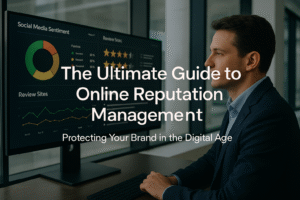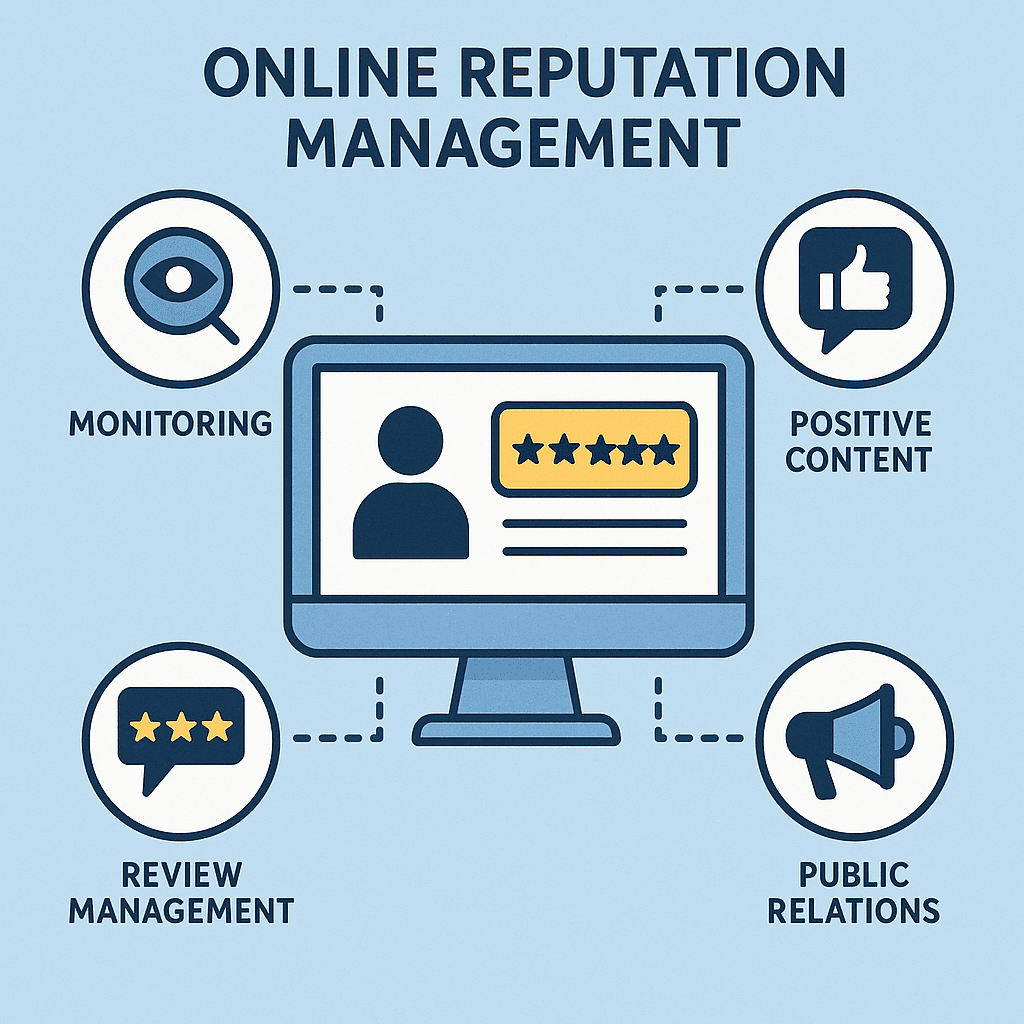The Ultimate Guide to Online Reputation Management: Protecting Your Brand in the Digital Age
What do people find when they Google your business name? The answer to that question is your modern-day first impression. In an era where trust is currency, your digital reputation is one of your most valuable assets. This guide will walk you through exactly what online reputation management (ORM) is, why it’s essential for survival, and how you can build a strategy to protect and enhance your brand’s image.
What is Reputation Management in Business? (And Why It’s Non-Negotiable)
Online reputation management in business is the ongoing process of monitoring, influencing, and managing the public perception of an organization, individual, or brand on the internet. It’s a multidisciplinary practice that combines marketing, public relations, search engine optimization (SEO), and customer service to build a positive and trustworthy digital footprint.
This isn’t just about damage control after a bad review. It’s a proactive strategy to shape your narrative across the entire digital landscape—from search engine results to social media conversations and review platforms.
According to BrightLocal, 98% of consumers used the internet to find information about local businesses in 2023. Your online reputation isn’t just a marketing metric; it’s the front door to your business.
Why is ORM so critical?
- Consumer Trust and Credibility: Today’s consumers are researchers. They look for reviews, ratings, and social proof before making a purchase decision. A positive online reputation is a powerful signal of trustworthiness.
- Impact on Sales and Revenue: A one-star increase in a Yelp rating can lead to a 5-9% increase in revenue. Conversely, negative reviews can actively drive potential customers to your competitors.
- Search Engine Dominance: Google’s algorithm rewards brands that demonstrate expertise, authoritativeness, and trustworthiness (E-A-T). Positive reviews and sentiment are considered signals of authority, which can improve your search rankings. ORM helps control what appears on the first page of Google for your brand name.
- Talent Acquisition: Top talent vets potential employers online. A reputation for a poor work environment, bad customer service, or ethical lapses on platforms like Glassdoor can severely hinder your ability to attract skilled employees.
Real-World Examples of Reputation Management in Action
Theory is one thing; practice is another. Let’s look at how ORM plays out in real-world scenarios.
The Proactive Example: Excelling at Review Management
Scenario: A boutique hotel chain actively monitors its profiles on Google Maps, TripAdvisor, and Booking.com.
Strategy in Action:
- For Positive Reviews: A manager responds to every 4 and 5-star review within 24 hours. The response is personalized, mentioning something specific from the reviewer’s comment (e.g., “We’re so glad you enjoyed the complimentary breakfast and the view from your room!”).
- For Negative Reviews: A 1 or 2-star review is treated as an urgent customer service issue. The manager apologizes for the specific problem, takes responsibility, and publicly offers to resolve the issue offline (“Please contact me directly at… so we can make this right.”).
Result: Potential guests see that the hotel values feedback and is committed to customer satisfaction. This builds immense trust and can even turn a negative situation into a display of excellent service, encouraging more bookings.
The Reactive Example: Handling a Crisis
Scenario: A popular local restaurant receives a viral TikTok video showing an unclean kitchen area.
Bad Strategy: Deleting comments, denying the issue, or ignoring it.
Good Strategy in Action:
- Acknowledge and Apologize (Quickly): The restaurant immediately posts a public statement on its social media channels. They don’t make excuses. They apologize for failing to meet standards and thank the person for bringing it to their attention.
- Take Action and Be Transparent: They state they are closing for 24 hours for a deep clean and professional health inspection. They post updates, perhaps even showing the cleaning process, to be fully transparent.
- Resolve and Rebuild: After reopening, they invite the local health inspector to do a public report, share the high score, and offer a promotion to win back community trust.
Result: While initially damaging, the swift, honest, and transparent response can actually strengthen a brand’s reputation in the long run. It shows accountability and a commitment to quality.
The Modern Toolkit: Online Reputation Management Tools & Platforms
Managing a reputation manually is nearly impossible. Thankfully, a wide range of powerful online reputation management tools and integrated reputation management platforms can automate and streamline the process.
| Tool Category | Primary Function | Popular Examples |
|---|---|---|
| Review Management | Aggregates reviews from dozens of sites into one dashboard and helps generate new reviews from happy customers. | Birdeye, Podium, Yext, ReviewTrackers |
| Social Media Listening | Tracks brand mentions, keywords, and sentiment across social media and the web, helping you catch conversations as they happen. | Brand24, Sprout Social, Mention, BuzzSumo |
| Search Engine Monitoring | Monitors search engine results pages (SERPs) for your brand name, alerts you to new mentions, and helps with SEO efforts. | Google Alerts (Free), SEMrush, Ahrefs, BrandMentions |
| All-in-One Platforms | Enterprise-level solutions that combine review management, social listening, surveys, analytics, and business listings in one suite. | Reputation.com, Meltwater, Talkwalker |
Building Your Online Reputation Management Strategy: A Step-by-Step Guide
Ready to take control? Here’s a practical framework for building your own ORM strategy.
Step 1: Conduct a Thorough Reputation Audit
Before you can improve your reputation, you need to know where you stand.
- Google Everything: Search for your company name, product names, and the names of key executives. Analyze the first three pages of results.
- Check Review Sites: Read your reviews on general sites (Google, Yelp), and industry-specific ones (G2 for software, Avvo for lawyers, etc.).
- Analyze Social Media: Search for your brand on X (Twitter), Facebook, Instagram, and TikTok. What are people saying?
- Set Up Alerts: Create free Google Alerts for all your key brand terms to get notified of new mentions automatically.
Step 2: Establish a Response Protocol
Consistency is key. Create clear guidelines for your team.
- For positive reviews: Always thank the reviewer. Be specific and genuine. This encourages more positive reviews.
- For negative reviews: Use the “4 A’s” formula: Acknowledge their frustration, Apologize sincerely, take Action to solve the problem, and provide a direct Answer (or a way to get one offline). Never get into a public argument.
Step 3: Proactively Build a “Digital Moat”
The best defense against negative content is a strong offense of positive content that you control. The goal is to own the first page of Google for your brand search. Create and promote high-quality content on properties you own:
- A professional, SEO-optimized website and blog
- Claimed and active social media profiles (LinkedIn, Facebook, X, Instagram)
- Press releases for newsworthy events
- Guest posts on authoritative industry blogs
- Case studies and customer testimonials
Step 4: Monitor, Measure, and Adapt
ORM is not a “set it and forget it” task. Use the tools mentioned above to continuously monitor your digital footprint. Track key metrics like:
- Overall star rating trends
- Volume of new reviews
- Sentiment analysis (positive, neutral, negative mentions)
- Rankings of your owned properties in search results
Use this data to refine your customer service, improve your products, and adapt your marketing strategy.
Frequently Asked Questions (FAQ)
Generally, no. It’s very difficult to remove a review unless it violates the platform’s terms of service (e.g., contains hate speech, is clearly spam) or is legally defamatory, which is a high bar to prove in court. Your best strategy is almost always to respond professionally to the review and drown it out with new, positive reviews.
The cost varies dramatically. You can start for free with tools like Google Alerts. DIY tools and platforms can range from $50 to a few hundred dollars per month. Hiring a specialized agency can cost anywhere from $1,000 to over $10,000 per month, depending on the scale of your business and the severity of your reputation issues.
They are closely related but have different goals. SEO (Search Engine Optimization) focuses on ranking your website for relevant non-branded keywords (e.g., “best coffee shop in brooklyn”). ORM (Online Reputation Management) focuses on controlling the search results for your *branded* keywords (e.g., “Joe’s Coffee Shop”) to ensure they reflect a positive and accurate image.
There is no quick fix. Responding to a single crisis might take a few weeks of intensive effort. However, fundamentally improving a poor reputation or building a strong one from scratch is an ongoing process that takes months and years of consistent effort. It’s a marathon, not a sprint.
-
How Inexperience Causes Massive Losses in the Forex Markets
Read More -
What Types of Marketing Are There? The Ultimate 2025 Guide
Read More -
Elements of a Decision Situation: A Comprehensive Analysis
Read More -
How to Build a Powerful Marketing Strategy
Read More -
The Ultimate Guide to Understanding the “Consumer”
Read More -
Online Reputation Management: Protecting Your Brand
Read More -
How Can I Invest In The Share Market?
Read More -
Is The Share Market Halal?
Read More -
The 7 Best Smart Notebooks of 2025: A Hands-On Review
Read More -
The 7 Best Sticky Notes of 2025: A Hands-On Adhesion Test
Read More -
The 5 Best Index Cards of 2025: A Hands-On Guide
Read More -
The 5 Best Quick Scanners: Tested for Speed & Simplicity
Read More




